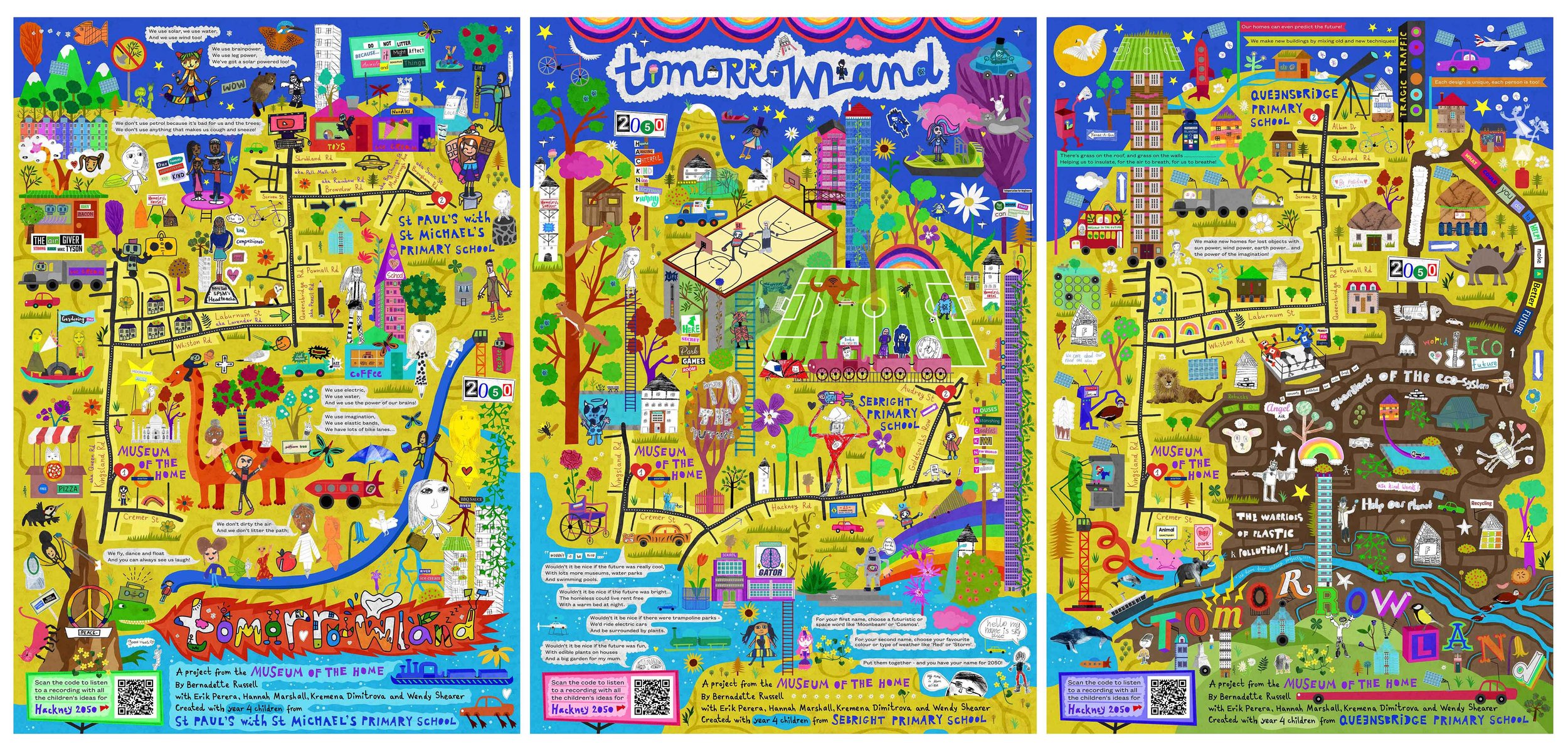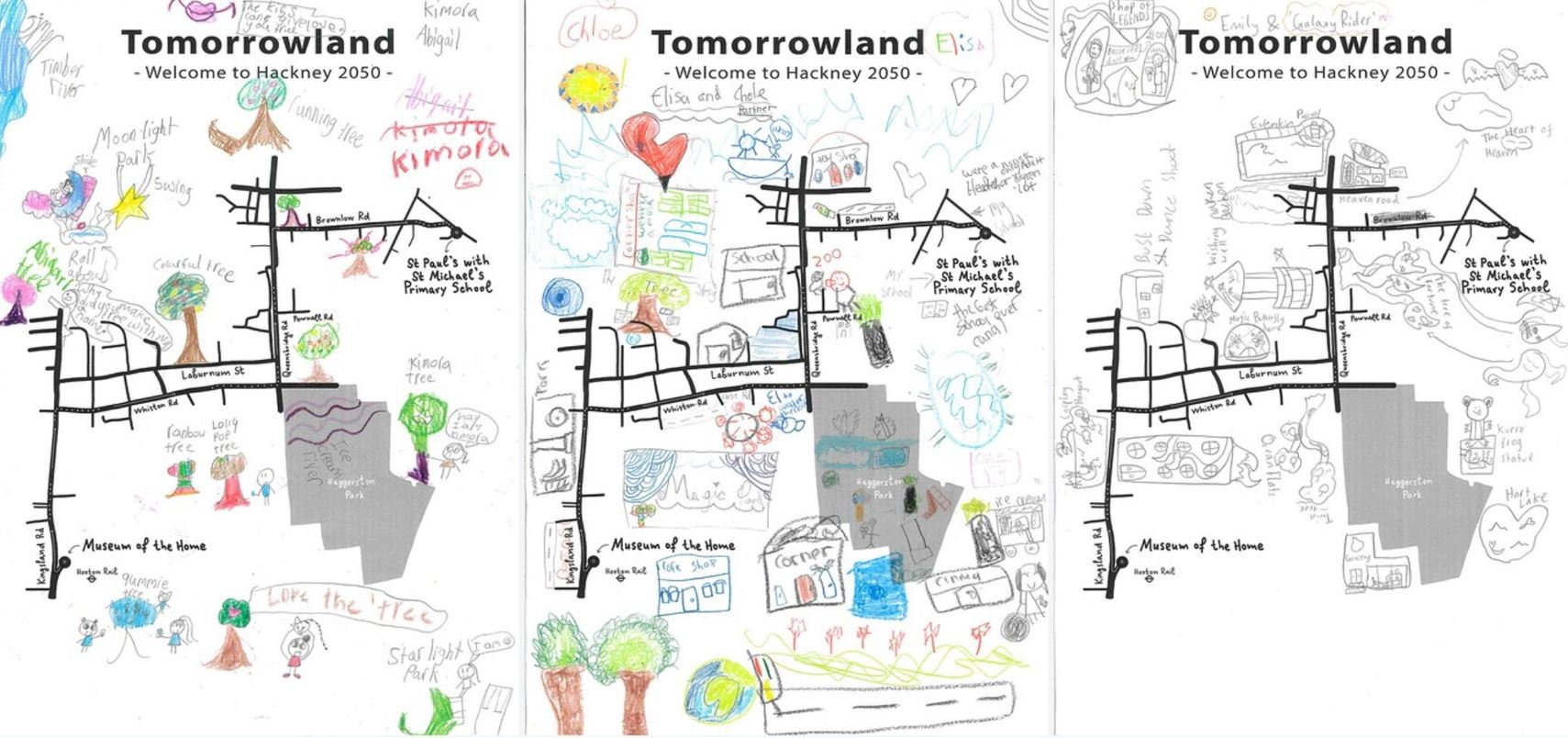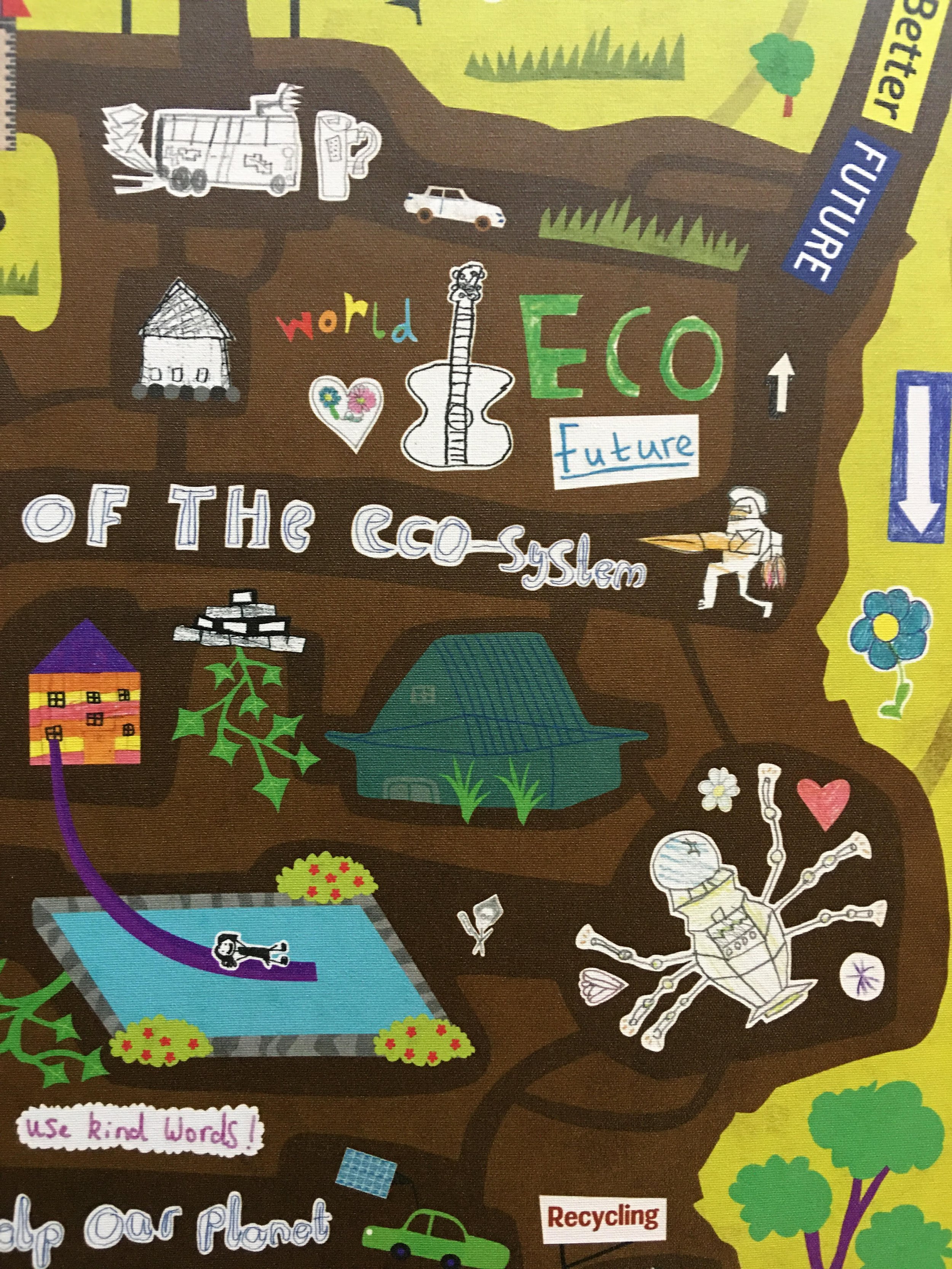Tomorrowland
Kremena Dimitrova
The collaborative maps produced by the team with three Hackney primary schools
“If we can build a successful city for children, we will have a successful city for everyone.
– Enrique Peñalosa, former mayor of Bogotá
The maps above come from Tomorrowland, a socially engaged and site-specific project that was partly inspired by Enrique Peñalosa’s hopeful statement. Tomorrowland is a map-based multimedia project co-created with the Museum of the Home (formerly the Geffrye Museum), in Hackney, east London. Working with year 4 children and teachers of St Paul's with St Michael's, Sebright, and Queensbridge primary schools in Hackney, this ambitious project was conceptualised and delivered during the Covid-19 lockdown by lead artist Bernadette Russell, who has a background in storytelling and theatre, in collaboration with illustrator and storyteller Kremena Dimitrova, author and storyteller Wendy Shearer, sound artist Erik Perera and composer and musician Hannah Marshall, with input from scientists from Queen Mary University of London.
Inspired by the themes of heritage, community, home, and the future, the purpose of the project was to creatively map the children’s ideas of home in 2050 as being more than the concrete buildings we occupy, thus promoting a wider perspective of home as being the places and spaces we walk through and enjoy on a day-to-day basis.
Said Russell: “We were working with three primary schools in Hackney and wanted to co-create something with them which delivered hope, fun, and creativity to the children, their teachers, and families at a time when there was so much expressed anxiety and fear, particularly around Covid-19 and climate change. An essential element of this project for me from the start was a map of the future.”
Russell, Shearer and Marshall delivered a series of creative workshops at the three schools in what was a form of teaching and learning through playfulness and entertainment, facilitating conversations and lasting connections between the children and their locality.
“Workshops were held weekly over six weeks which allowed plenty of collaboration time with each other,” Shearer said. “The children were allowed to let their imagination run free by writing stories, poetry, and drawing their ideas.”
The base maps designed by Kremena Dimitrova
Dimitrova drew simple maps in preparation for the workshops which were printed by the team and handed to the children to draw on. These served as a focus to engage the children in storytelling discussions and activities which uncovered and recorded narratives and memories, and provided opportunities to use their creativity to express how they felt about home by drawing, writing, and mapping their personal and collective visions.
“Their ideas were all rooted in current inventions and research that we shared during our weekly workshops,” said Shearer.
The children had ideas about everything from food, buildings, parks, bins, transport and traffic to animal translators and dog sanctuaries, positive graffiti and fair salary projects through Robucks (a new currency). Along the way, they talked about robot boxing rings, automatic ice sculptures, angel air songs, floating jewellery, solar battery developments, all-weather iPhone hoodies, and guardians of the ecosystem.
“We all worked together,” said Russell, “sharing ideas, delivering workshops, and producing material which could be used to contribute to the maps.”
All the textual and visual creations were painstakingly documented and passed on to Dimitrova, who with Russell sifted through and edited down the enormous amount of material created, looking for overlapping themes and making sure that all children were represented. Meanwhile, Russell also worked with Perera to co-create audio pieces with each of the classes, which enhanced the ideas of the maps.
“These audio recordings complemented the maps so that people could listen to them while following the routes or just enjoy them separately,” said Shearer.
To ensure the children owned the project, Dimitrova kept the children’s original drawings and writings unaltered by creating digital collages so the children can easily spot and pinpoint their work on the maps.
Beyond wayfinding, which is helpful in its own right, the team believe maps are about journeys, storytelling, hopes, dreams, imaginations, and much more – maps are magic. The playful map posters, through written and spoken words, rhymes and poetry, drawings of ideas, curiosity, daring, and a hint of humour, allowed the children’s voices to be seen and heard, inviting them to walk through their stories in time and space for years to come. By incorporating elements from comics, such as thought, speech, and scream bubbles, Dimitrova was able to clearly illustrate what the children think about home, and what they want to want to say about it.
As Shearer said: “These maps were intended to give a snapshot of present-day Hackney through the eyes of local children while sharing their hopes and dreams for the future.”
A detail from one of the maps the team made with the children.
Together, the team co-created multifaceted and vivid outcomes of artistic integrity that are intergenerational, educational, interactive, inclusive, and memorable and that can cater for the different interests of children and adults alike. Text-image works are arguably more accessible since some people prefer reading words while others prefer reading pictures. We ensured that in our maps, the images do not merely illustrate the words, but tell their own stories.
They see the result as a series of legacy pieces that encourage moments of exchange, connection and belonging. One aim was to remind the children, while walking to and from their schools and the Museum of the Home that the museum is a welcoming place and a local resource that cares about and shares their perspectives.
The tryptic A0 digital and physical poster maps were designed by Dimitrova with the aim to work visually on their own, as a collaborative exhibition at the museum, and as a set, with each of the three schools receiving the poster map they had contributed to. They can be used for various purposes, from exhibition displays and creative wayfinding resources to self-guided walks or simply as keepsakes to look at and admire. While the maps can be used simply to navigate from the museum to the three individual schools, they also show the children’s visions of their area in 2050, or in Shearer’s words, “what they would love the world to become by the time they are grown up” – even if that includes the Taj Mahal being situated near the museum.
“This impactful visual expression of the future provided an accessible and inspiring outcome of a complex and ambitious project, and to me ‘mapping the future’ is essential for our collective positive mental health and as a way of helping us see what is possible, through the eyes of children,” Russell said. “For me, the most wonderful thing about this project was the rich collaboration of scientists, artists, teachers, and children, resulting in a powerful, witty, and hopeful vision of our future.”
From a creative point of view, collaboration and co-creation are not easy undertakings and there was much to be considered in terms of representation, what information to include or exclude, how and why. To give a comprehensive view of this project, the Museum of the Home compiled an archive of the children’s creations which is accessible online to look through, enjoy, and learn from.
The maps and materials generated by the Tomorrowland project would appeal to “audiences such as other schools, locals, and anyone else who would be interested in visiting or finding out about Hackney”, said Shearer. But the journey and process were as important as the outcome. Tomorrowland gave children the opportunity to meet, be inspired by, collaborate, and co-create with professional creative practitioners, and generated pride for all taking part. Hackney and other boroughs could benefit from supporting and setting up similar pilot projects for children and young people, and the community more generally.
In retrospect, Tomorrowland was timed perfectly, taking place as it did during the Covid-19 crisis when many creative initiatives were either cancelled or postponed. The project also responded to the ongoing collaborative and socially engaged shifts within the museum and heritage sector which ensure that communities are at the heart of (hi)storytelling co-production.
Author
Kremena Dimitrova: kremenadimitrova.com
You can find out more about the project, view the children’s artworks, and listen to their stories online at Tomorrowland | Museum of the Home or visit the Museum of the Home, 136 Kingsland Road, London E2 8EA.


